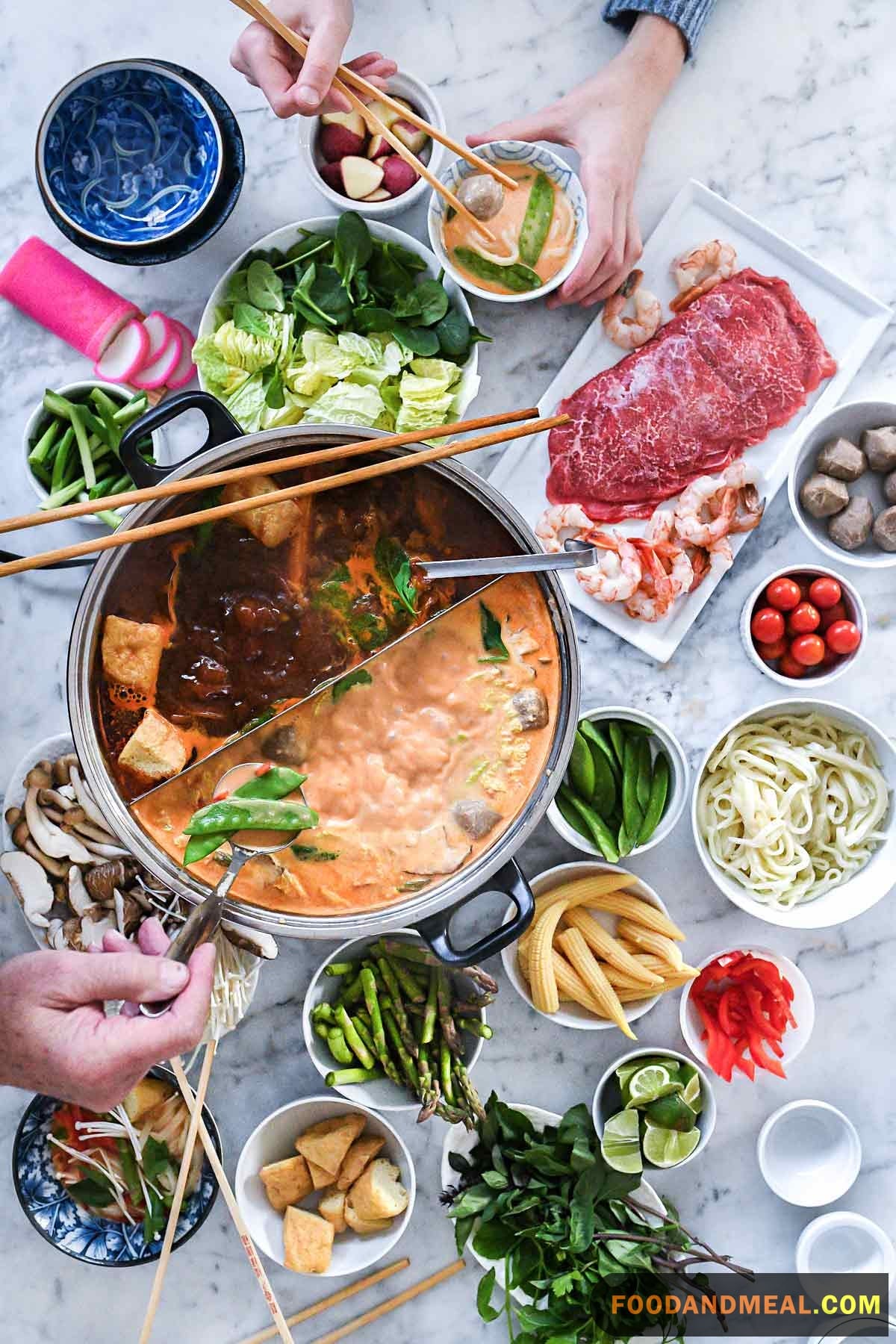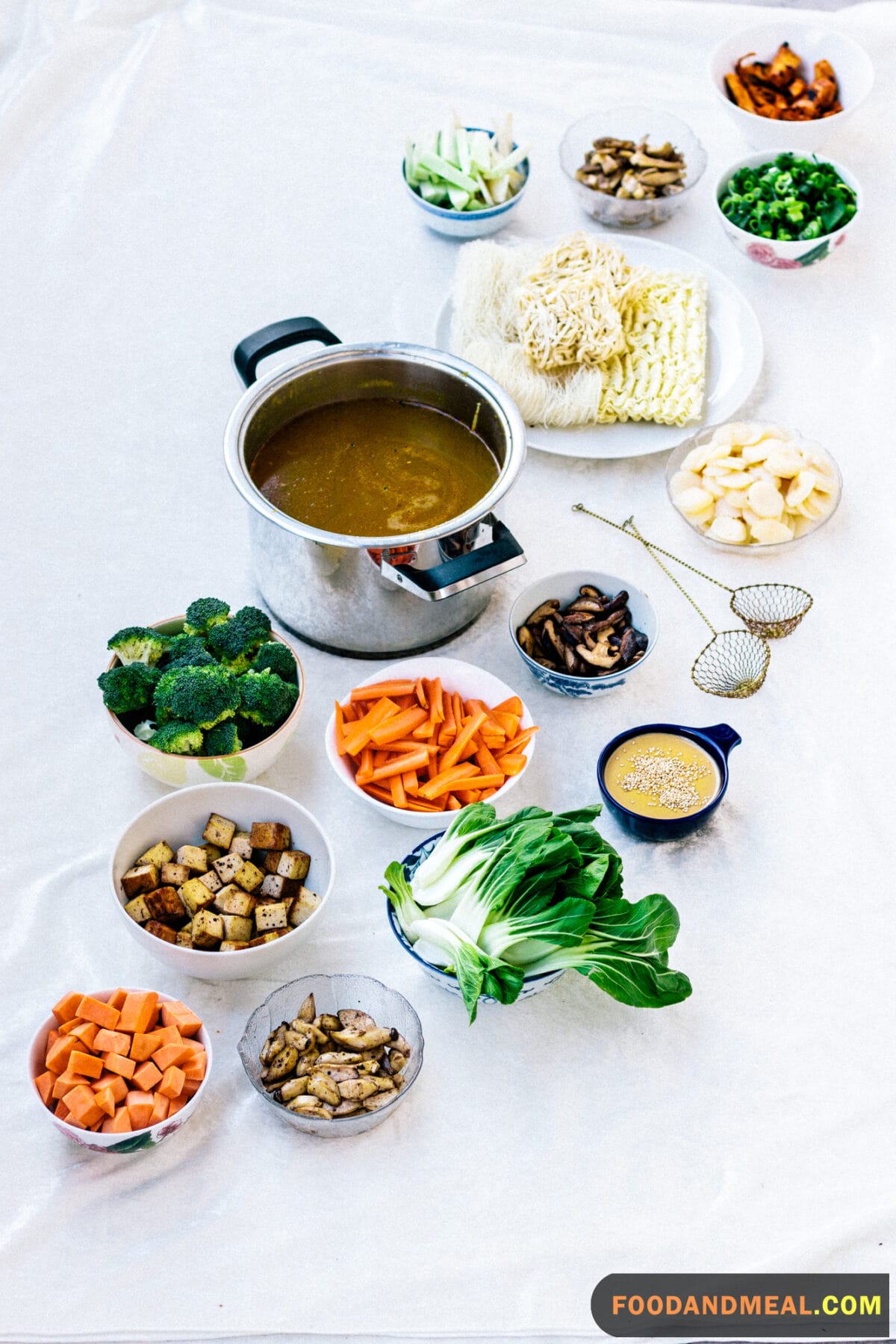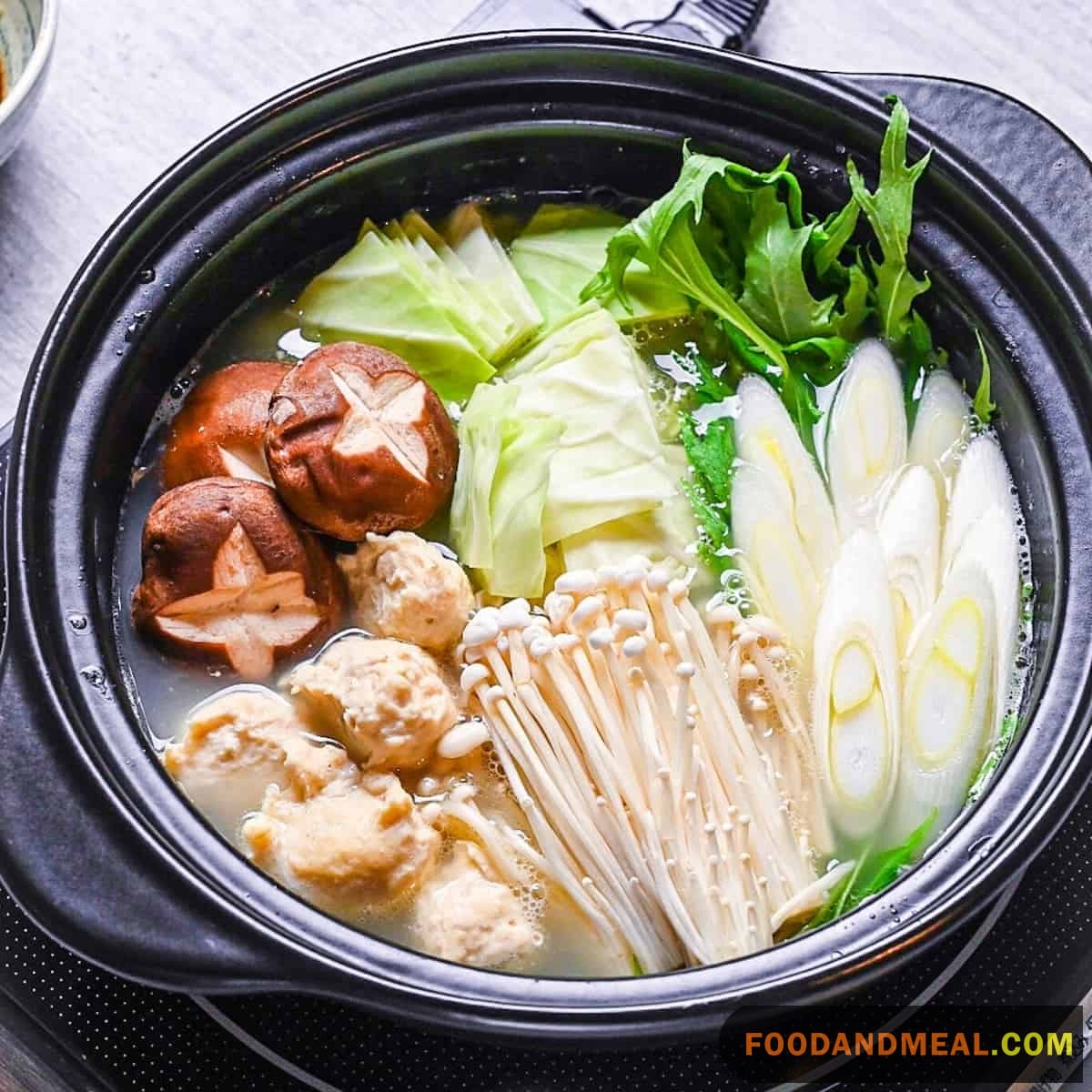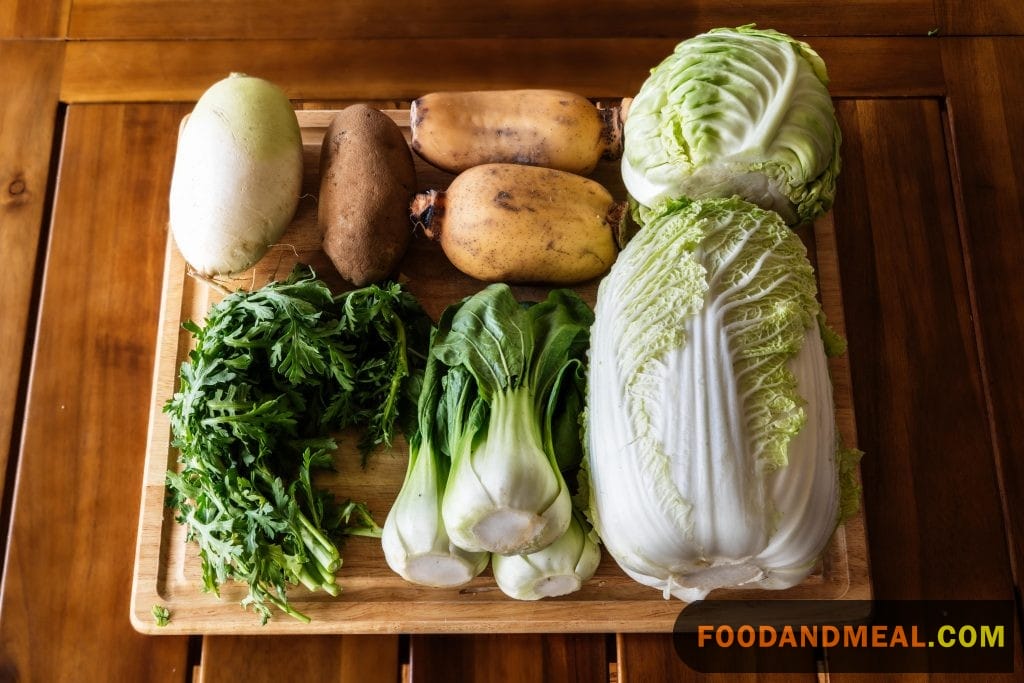As the weather turns colder, I find myself craving warm, comforting meals that bring my family together around the dinner table. That’s why I was so excited to discover Japanese hot pot, or nabemono. This interactive one-pot meal is perfect for chasing away the winter chill!
In my research on traditional ingredients for nabemono, I learned that “vegetables, mushrooms, meat and seafood are cooked in a pot of flavorful broth”. The broth also usually contains “water, sake, soy sauce, mirin and dashi soup stock”. Some popular hot pot dishes like Shabu Shabu even use thinly sliced meat cooked right in the broth.
While those traditional versions sound delicious, I wanted to put together a vegetarian version that my whole family could enjoy. The great thing about hot pot is that “you can change it up for your preferences because almost anything goes!”. I decided to focus on making this a healthy, plant-based meal by using lots of vegetables, tofu for extra protein, and a flavorful homemade broth.
Hot pot also has the benefit of being “a social and interactive dining experience” which brings my family together. We’ll gather around the bubbling pot adding ingredients and telling stories – the perfect antidote to these long winter nights. I can’t wait for my kids to taste their first homemade Japanese veggie hot pot!

Veggie Hot Pot Recipe

Japanese Veggie Hot Pot
Ingredients
For broth:
For your diners to cook
- cabbage, Bok choy and/or spinach
- Tofu, firm
- Noodles, udon, egg, dried or fresh
- Sesame dipping sauce, bottled
Instructions
- Place broth ingredients in pot on med. heat on stove. Bring to a boil. Cover and simmer for 1⁄2 hour or so.
- Place pot on portable burner on dinner table.
- Provide diners with ladles, skewers and bowls and allow them to cook their veggies and tofu as they prefer. Have dipping sauce available.
Video
Notes
Nutrition
© Food And Meal
This website provides approximate nutrition information for convenience and as a courtesy only. Nutrition data is gathered primarily from the Spoonacular Database, whenever available, or otherwise other online calculators.
Preparing Veggie Hot Pot in a Pressure Cooker
Prepare your vegetables for a Veggie Hot Pot using a pressure cooker. Sauté aromatics in sesame or neutral oil, add vegetable broth, and start with heartier veggies like carrots. Cook on high for 3 minutes to retain freshness. After a quick release, add delicate vegetables and simmer without sealing the lid for 5 more minutes. The result is a flavorful and vibrant Veggie Hot Pot ready to be served piping hot in individual bowls.
Cooking Tips

Making Japanese veggie hot pot at home can seem intimidating, but with a few helpful tips it’s actually quite easy! The key is having the right ingredients prepped and ready to go before you start cooking.
I recommend slicing your vegetables and tofu into thin, bite-sized pieces so they cook quickly in the broth. Mushrooms also work nicely. Make sure you have a good selection – I love adding carrots, bok choy, cabbage, bean sprouts and shiitake mushrooms. The more variety, the better!
It’s important to make a flavorful veggie broth. I like to use vegetable stock along with soy sauce, mirin, sake and ginger. Let it come to a simmer before adding your veggies so all the flavors infuse.
Once your broth is ready, set up your pot on the table and invite everyone to gather around. Keep the broth at a gentle simmer as you add ingredients. Letting everyone add their own favorites makes it fun and interactive. Just be careful not to overcook the veggies!
Have some dipping sauces on hand to customize your experience. I provide sesame sauce, ponzu and a spicy chili sauce. My kids love experimenting with the different flavors.
Serving Suggestions

Begin with the freshness of Vegetable Maki rolls, each bite delivering a perfect contrast of textures to the heartiness of the hot pot. For an added layer of flavor, consider Soy Sauce Eggs, their savory notes harmonizing seamlessly with the vegetable-centric broth.
For those seeking indulgence, Wok Fried Crab presents itself as a luxurious accompaniment. Succulent crab meat, expertly prepared, introduces a richness that blends beautifully with the vibrant flavors of the hot pot. To infuse a touch of playfulness into the meal, serve Norimaki Mochi, where the delightful chewiness of mochi wrapped in seaweed adds a unique element to the dining experience.
For a refreshing interlude, introduce Tofu Hiyayakko, a chilled tofu dish that offers a cool contrast to the warmth of the hot pot. Teriyaki Shrimp provides a seafood delight, the sweet and savory teriyaki glaze elevating the overall taste profile. To satisfy noodle cravings, a bowl of Tonkotsu Ramen on the side is a hearty addition, offering a delightful contrast to the vegetable-centric main course.
For those seeking a fusion experience, Yakimiso Ramen is an inspired choice. The grilled miso flavor in the ramen brings a distinctive twist to the traditional noodle dish, harmonizing unexpectedly well with the Veggie Hot Pot.
FAQs of Veggie Hot Pot

- What is in a traditional Japanese hot pot? A traditional Japanese hot pot, often known as “nabe,” typically consists of a flavorful broth base, a variety of fresh ingredients such as thinly sliced meats, seafood, tofu, and an assortment of vegetables. The ingredients are cooked at the table in a communal pot, and diners can customize their experience by dipping the cooked items into various sauces.
- What are 3 popular Japanese hot pot dishes?
- Sukiyaki: This hot pot features thinly sliced beef, tofu, vegetables, and shirataki noodles cooked in a sweet and savory soy-based broth. The ingredients are often dipped into a raw beaten egg before eating.
- Shabu Shabu: Thin slices of meat, usually beef or pork, are swirled in a hot pot of broth until just cooked. Diners then dip the cooked meat into various sauces. Shabu Shabu emphasizes simplicity and the quality of the ingredients.
- Yosenabe: Yosenabe is a versatile hot pot that typically includes a mix of seafood, meat, tofu, and an abundance of vegetables. It’s known for its flexibility, allowing a wide range of ingredients to be used based on personal preference and seasonal availability.
- What vegetables are good in hot pot?
A variety of vegetables can enhance the hot pot experience. Common choices include:
- Leafy Greens: Napa cabbage, bok choy, and spinach.
- Root Vegetables: Carrots, daikon radish, and sweet potatoes.
- Mushrooms: Shiitake, enoki, and shimeji mushrooms.
- Alliums: Green onions, garlic, and leeks.
- Other Veggies: Corn, mushrooms, and bell peppers.
- What is the difference between Shabu Shabu and Yosenabe?
- Shabu Shabu is a hot pot dish where thinly sliced meat is swirled in a hot pot of broth until just cooked. It is known for its simplicity and emphasizes the quality of the ingredients. Diners typically dip the cooked meat into various sauces.
- Yosenabe, on the other hand, is a versatile hot pot that often includes a mix of seafood, meat, tofu, and an array of vegetables. It is characterized by its flexibility, allowing for a wide range of ingredients to be used based on personal preference and seasonal availability. Yosenabe is less about the dipping process and more about creating a hearty, diverse stew with various ingredients.
- Can I use frozen vegetables for the Veggie Hot Pot?While fresh vegetables are recommended for the best flavors and textures, frozen vegetables can be used as a last-minute substitute. Ensure they’re thoroughly thawed and drained to avoid watering down the broth.
- I don’t have the mentioned vegetables; can I improvise?Absolutely! The beauty of a Veggie Hot Pot is its flexibility. Use what you have on hand or what’s in season, ensuring you adjust the cooking time accordingly.
- How spicy is this hot pot?The Veggie Hot Pot, as described, has a mild flavor profile. However, you can increase the heat by adding more chili or serving with a spicy condiment.
- How do I store leftover Veggie Hot Pot?Let the hot pot cool down to room temperature. Transfer it to an airtight container and store it in the refrigerator. It’s best enjoyed within 2-3 days for optimal freshness.
- Can I reheat the Veggie Hot Pot?Yes, you can reheat it on the stovetop until it’s simmering. Ensure it’s heated through before serving. Avoid reheating multiple times as it can make the vegetables too soft and lose their original texture.
Conclusion
In conclusion, the Japanese Veggie Hot Pot is a delicious and healthy one-pot meal perfect for gatherings with family and friends. This vegetable-packed hot pot features a variety of mushrooms, leafy greens, tofu, and noodles simmered in a flavorful dashi or miso broth. As outlined on Food and Meal (foodandmeal.com), it can be customized with your choice of vegetables and customized to be vegan by using kombu dashi. Served alongside a bowl of rice or udon noodles, it makes for a comforting, crowd-pleasing meal. Garnished with scallions, chili oil, or a Japanese citrus like yuzu, it balances the rich broth with bright acidic flavors. For beverage pairings, consider serving oolong or jasmine tea, Japanese beer, sake, or non-alcoholic mugicha barley tea. This one-pot wonder checks all the boxes – healthy, delicious, and fun for sharing with family and friends.
Hi! I'm Nazia of ‘Nazia Cooks’, a self-taught baker and cook residing in Chennai. Rooted in the rich South Indian culinary landscape, my palate has expanded to embrace global flavors. I revel in crafting fusion dishes, melding traditions to birth unique tastes.



